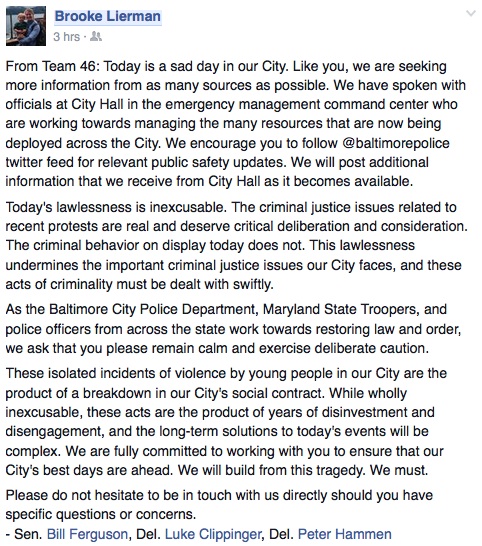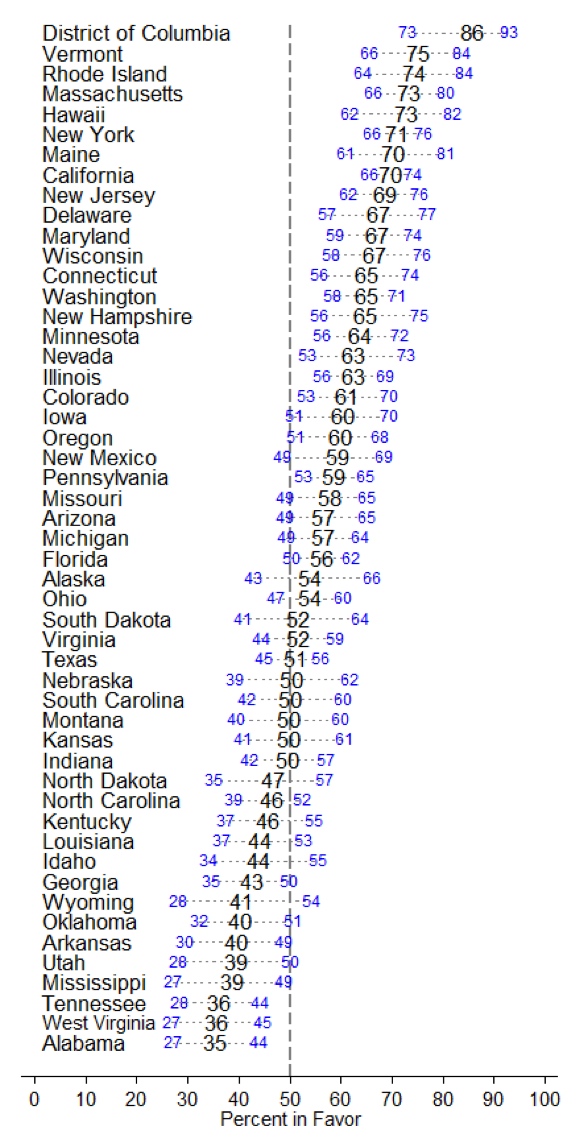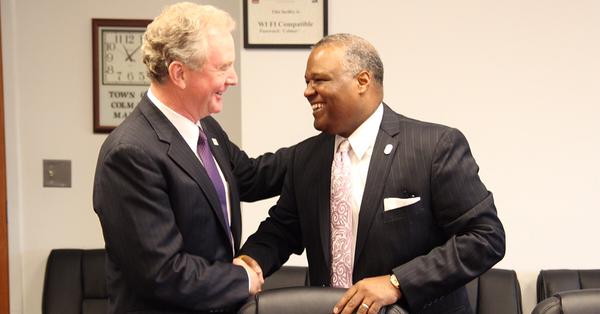Legislators posted the following on Facebook earlier today:
Monthly Archives: April 2015
Hogan Restructuring MTA
Republican Gov. Larry Hogan, has fired Robert Smith, a Democratic appointee, as head of the Maryland Transit Administration. This move is part of a larger effort to restructure MTA in the face of problems of facing the agency:
The agency is a year late in producing a promised plan for improvements to its beleaguered Baltimore bus network, is facing a class-action lawsuit from transit riders with disabilities who use its Mobility service, and hasn’t met a state mandate that it provide 35 percent of its operating budget through fare revenue since 2005.
Ridership across all MTA transit modes — including local buses, light rail and MARC train service — was down in 2014, though it has rebounded some this year.
The Baltimore bus network has been a particular problem. MTA’s inadequate slow motion plan to improve buses is scheduled over 18 years. The Baltimore Sun reports that the Transportation Secretary plans to review the plan.
Smith explained that aging infrastructure is a big part of the challenges that MTA faces:
“It’s an aging system. The Metro itself is 30 years old. The light rail is at mid-life,” he said.
Hogan’s First Session Endgame
Evaluating outcomes of legislative sessions, particularly when the Democrats control the General Assembly the Republicans the Governor’s Mansion, often devolves into rating winners and losers. Though there were the inevitable clashes on policy and rhetoric, it was also a productive session.
The sour note finish on the budget, however, was a perplexing surprise in light of the initial bipartisan budget compromise that saw strong support from both sides of the aisle. Bipartisan comity unraveled towards the end of the session.
Though Gov. Hogan’s staff had been highly involved in the budget negotiations that led to the brief budgetary Era of Good Feelings, he decided to insist on adding another $75 million to the pension fund after the compromise was reached.
The Governor’s reinsertion of this demand after agreement had been reached will harm future negotiations with the legislature. It reduces legislative trust that he will adhere to deals and makes legislators wonder if he really prefers an argument to policy accomplishments.
The new attempt at negotiations after the pension demand reemerged also flopped. My colleague, Todd Eberly, largely blames the Democrats for not taking Hogan’s offer to partly reach their goals on education, health and COLAs for government employees in exchange of hewing to his demands on pensions.
While certainly a reasonable enough viewpoint, Hogan’s demands went well beyond pension funds to include passage of virtually all of his other bills. Negotiations in which the Governor expected the whole menu for only partial budgetary concessions were not likely to succeed.
There are further reasons for this failure. Gov. Hogan and his team did not lobby rank-and-file legislators nearly as aggressively as Gov. O’Malley during the legislative session. The lack of contact felt Jimmy Carter-like at times. His staffers need to work not just with legislative leaders but other legislators to advance their bills. President Miller and Speaker Busch are important but they are not the whole General Assembly.
The light lobbying touch may also be a symptom that Gov. Hogan believes that the General Assembly rolled over for Gov. O’Malley and so they should do the same for him. Except that many Democrats often fought with O’Malley and he had to fight very hard to get his priorities from gambling to same-sex marriage passed.
No doubt there is a learning curve for every new governor. While Gov. Hogan was the Appointments Secretary for Gov. Ehrlich, he has less experience in dealing with the General Assembly. His first session was hardly a failure. But whether his second session goes better will depend not just on Democrats but on him.
Support for Marriage Equality at 67%
The Williams Institute released a report dog-bites-man story that support for marriage equality continues to increase across all 50 states and DC. Support is currently at 67 percent in Maryland. (The purple numbers show the outer bounds of 95% confidence intervals. True public opinion has a 19 in 20 chance of falling within these bounds.)
Support for Marriage Equality
Source: The Williams Institute
Bankrupt, Homophobic Wayne DuPree Speaking at GOP Convention
Apparently, his appearance with the Maryland College Republicans was a hit and is now being followed up with a speech at the Maryland Republican Convention in Ocean City.
Literally and Morally Bankrupt
This anti-government pick-yourself-up-by your-bootstraps-guy filed for bankruptcy in 2014. So this hypocrite took advantage of the same laws that Republicans regularly deride. DuPree is also no stranger to foreclosure proceedings on property that he owns (see here, here, here, and here). Ironically, this debtor has no compunction about attacking people on welfare as “takers” and thinks unemployed people are lazy who don’t want to work.
Gays are “Sick” and “Perverts”
This (divorced) ardent homophobe defended Dr. Ben Carson’s lumping together of” bestiality with gay marriage” and then upped the ante by lumping gays with pedophiles and necrophiles:
Anyways the Dr. is right… Marriage is for ‘normal’ or ‘natural’ people… and in no way should it be degenerated into a ‘contract’ between ‘whatever’ and ‘whatever’ be they GBLT or pedophiles, zoophiles, necrophiles, etc. The obsession of the GBLTs is that in their minds everyone has to agree with their delusion of reality. You don’t see religious people wanting EVERYONE to believe in their version of reality. Live and let live. Stick to civil unions and fight for all the rights you may want… the desire to change the meaning of a word is a SICK desire to pervert a word defined/designed to PROTECT children and women and convert it into a word that is a selfish right… not caring at all for the rights of the children nor the women.
A past CPAC blogger of the year, DuPree believes that gays and lesbians can be “healed” after speaking in tongues at a church service, as stated in the title of his blog post with this video:
Similarly, he advertised the story of a “Former Lesbian Christian Rapper says Gays Can Change Like She Did.”
Debate I’d Like to See
I’d love to see a debate between Howard County Executive Allen Kittleman and Wayne DuPree. It would be interesting to see if young Republicans think which one of these two holds the views that are the past or the future of their party.
Regardless, it certainly places people like the Montgomery County Young Republicans, who would liked to be perceived as tolerant, in an awkward position. The MoCo YRs recently tweeted this at me regarding LGBT rights:
You can’t tout tolerance and have Wayne Dupree speak at your convention.
Baker and Leggett on Race and Endorsements
Prince George’s County Executive Rushern Baker got asked essentially why he, as an African-American leader, endorsed a white man over a black woman for U.S. Senate. Baker responded well and then Montgomery County Executive Ike Leggett jumped in to give an exceptionally eloquent statement:
Regardless of whether you prefer Van Hollen, Edwards, or someone else, their answers as to why they support Chris Van Hollen speak to the content of both of these gentlemen’s character.
Hogan Threatens Legislative Leaders
Gov. Larry Hogan tweeted this out yesterday via his campaign organization, Change Maryland:
This is one of those wonderful threats that is clearly meant one way–if you don’t bend, I’ll make electoral trouble for you at home–but Hogan’s press people will try to spin as we’re hoping that they’re listening to their constituents.
Somehow, I doubt they’re intimidated.
It’s also an argument that only goes so far. Democrats won so many seats in the General Assembly that Gov. Hogan cannot sustain a veto without Democratic support. Legislators have mandates too.
Bad Day for Donna Edwards
Rushern Baker Endorses Chris Van Hollen
Prince George’s County Executive Rushern Baker’s endorsement of Rep. Chris Van Hollen over Rep. Donna Edwards for U.S. Senate shows the tough road ahead for Edwards as the primary contest progresses. Not all endorsements matter. This one does.
While Van Hollen has the united support of the Montgomery County Executive and County Council, Edwards just lost the most prominent local official in her home base. Van Hollen has easily consolidated political support in his home base. In contrast, Edwards has now been served notice that she will have to fight hard to get Prince George’s to swing behind her.
It reinforces the existing media narrative that Edwards doesn’t work well with others either in Maryland or Congress. Moreover, it serves as a powerful signal to other African-American officials that it’s OK to endorse Van Hollen over Edwards. A further subtext is that Baker thinks Van Hollen will win so you should support early.
Edwards will try and counter as the authentic progressive candidate running against a corrupt establishment as when she challenged successfully Al Wynn. Except that she’s now a Member of Congress and part of the establishment so people want to see effectiveness as well as an ability to speak truth to power.
Moreover, neither Van Hollen nor Baker are Wynn. Both have strong reputations of wanting to clean up politics. Van Hollen, for example, has been a champion of campaign finance reform. The insufficiently liberal narrative won’t work on Van Hollen either and may just end up reinforcing that Edwards is less electable.
If Elijah Cummings enters the race, this can’t hurt him either, as it makes it easier for him to reach out to Prince George’s. In short, Cummings looks to have an easier time making inroads into Edwards’s base than vice-versa.
Are Transit “Advocates” Their Own Worst Enemy?
Greater Greater Washington’s David Alpert’s went off on Maryland Transportation Secretary Pete Rahn in a recent blog post, accusing him of wanting to “slash and burn” WMATA:
Meanwhile, Pete Rahn, the new Maryland transportation secretary who insists he’s not a “highway guy,” wants to cut costs much more deeply. He wants WMATA to completely shelve any talk about expanding the system or even increasing the number of eight-car trains.
Only in the Greater Greater Washington bubble is failing to build new lines or stations for Metro a “slash and burn” approach or cutting costs. Alpert continues:
Rahn told Hauslohner and McCartney that “Discussions of expansion have to be deferred for maintenance, and it means saying ‘no’ to some popular things until [Metro] has addressed throughout its system the issues of performance and safety.”
While maintenance is extremely important, it’s also dangerous to completely ignore anything else. While Metrorail ridership has declined slightly, the overall trend is toward hitting capacity ceilings—not to mention the Blue Line, which is suffering right now.
People who ride Metro with any frequency are going to view Rahn’s focus on getting the system working again as just plain common sense. Yesterday’s shutdown of the Bethesda Metro Station due to a lack of working escalators only emphasized the point if endless single tracking hadn’t already.
Alpert wants to call the stagnation in Metro ridership a blip but it has been going down since 2009. I bet that would change if the system worked better. At that point, I’d be glad to push for more eight-car trains–and so would the public and maybe Rahn.
Alpert tops it off with an out-of-touch analogy:
Rahn would certainly not say that Maryland should cancel any plans for even the smallest local road capacity increase project until every road and bridge is in tip-top shape and nobody ever dies on the roads, period.
Forehead hits keyboard.
Metro is not falling just short of “tip-top shape.” It’s seen as failing to do its job. For public transit to attract riders and provide the economic and transportation benefits, it has to be dependable. And Metro just isn’t anymore.
Indeed, Rahn’s notion that the financial and operational mismanagement must end before expanding the system will strike many as the arrival of rational voice. As the Washington Post pointed out, Metro didn’t even manage to spend its capital budget last year:
Rahn complained that Metro hasn’t been spending all of the money it has available to buy or modernize equipment while saying it needs more money.
Last year, Metro failed to spend $207 million, or 21 percent, of its 2014 capital budget that was meant to go toward maintenance, program management and vehicles, among other projects. According to the transit authority’s latest figures, Metro had only spent about 26 percent of this year’s capital budget by the time it was midway through the fiscal year.
Moreover, even when they manage to spend it, there are no often no real improvements. For example, little progress has been made on the escalator front with many breaking down soon after being rebuilt.
Echoing Alpert’s critique of Rahn for wanting to get a handle on costs and fix the system we have seems an excellent way to assure that approval ratings for Rahn’s boss, Gov. Larry Hogan, go up and he wins reelection in 2018.
Reporters v. Data: Millennials Edition
On March 29, the Washington Post published yet another of many stories on how millennials love the city and hate the suburbs:
Transit-centric millennials . . . who were born between 1980 and the early 2000s, are causing angst in traditionally car-dominant suburbs such as Montgomery County. Suburbs nationwide have long lured companies — and the high-skilled workers they seek to attract — with good schools, relatively low crime and spacious corporate campuses surrounded by vast parking lots near major highways.
A realization is growing among those communities’ business and civic leaders that the traditional suburban brand needs an overhaul.
The story had several anecdotes but had no actual data to support its conclusion that people are no longer moving to the suburbs. One reason for that omission is that it isn’t true, as reported on FiveThirtyEight:
According to U.S. Census Bureau data released this week, 529,000 Americans ages 25 to 29 moved from cities out to the suburbs in 2014; only 426,000 moved in the other direction. Among younger millennials, those in their early 20s, the trend was even starker: 721,000 moved out of the city, compared with 554,000 who moved in.1 Somewhat more people in both age groups currently live in the suburbs than in the city.
Indeed, for all the talk of the rebirth of American cities, the draw of the suburbs remains powerful. Across all ages, races, incomes and education groups, more Americans are still moving out of cities than in. (Urban populations are still growing, but because of births and immigration, not internal migration.)
There have been some important changes but they’re about delaying moves to the suburbs
The common narrative isn’t entirely wrong about the long-term trend lines. Millennials are moving to the suburbs at a much lower rate than past generations did at the same age. In the mid-1990s, people ages 25 to 29 were twice as likely to move from the city to the suburbs as vice versa. Today, they’re only about a quarter more likely. But even that slowdown appears to be mostly about people delaying their move to the suburbs, not forgoing it entirely. Today’s 30- to 44-year-olds are actually heading for the suburbs at a significantly faster rate than in the 1990s.
And the move to the suburbs isn’t being driven by moves to new urban areas like Bethesda and Silver Spring. The home with a yard for the kids to play remains popular. Indeed, the exurbs are still the fastest growing areas:
But a survey released earlier this year found that most millennials still want a traditional suburban experience, complete with big single-family homes. The American Community Survey, which provides a more granular look than the data released this week, tells much the same story, said Jed Kolko, chief economist of the real estate site Trulia.
“The fastest population growth right now is in the lowest-density neighborhoods, the suburb-iest suburbs,” Kolko said.
FiveThirtyEight hypothesizes why this story has gained traction even though it’s not true:
So why has the “city-loving millennials” story gained so much traction? Kolko has a theory: As American cities have become safer and more expensive, they have become increasingly dominated by the affluent and well-educated — exactly the people who drive the media narrative.












